The Ultimate Guide To Sweet And Sour Sauce
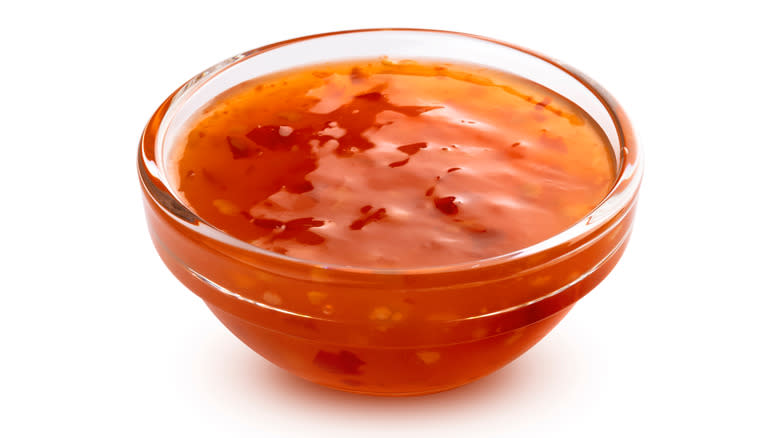
If you have ever eaten at an Asian restaurant, you will surely be familiar with sweet and sour sauce. This (usually) orange sauce is often an accompaniment to chicken, sweet and sour pork, fish, or duck, and is used for dipping or as a glaze.
The beauty of this sauce comes from its simplicity. Whether you make it at home or buy it from the store, there are always two main components: sweet and sour. The juxtaposition of these two very different flavors makes for a delightful treat for the palate, which is why it has been a part of many cultures' cuisines (not just Asian cultures, as one might think) for centuries. In this guide to sweet and sour sauce, we are going to take a dip into the history and use of this popular condiment to find out why it has such staying power and how you can incorporate it into your own dinner menu.
Read more: 11 Of The Best Cooking Tips From Bobby Flay
What Is Sweet And Sour Sauce?
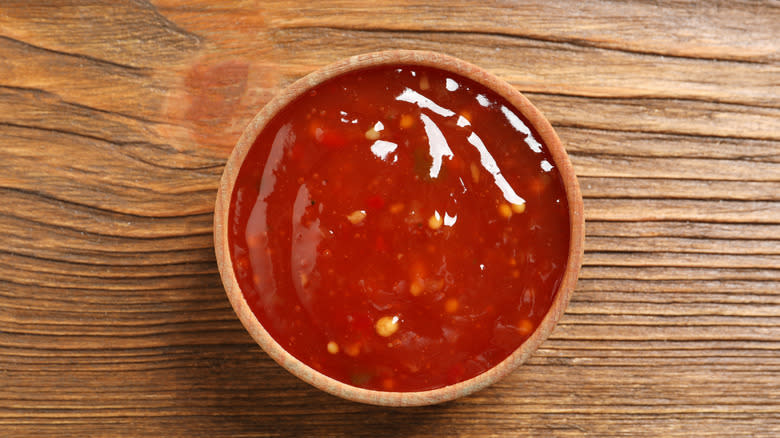
Sweet and sour sauce is a sauce that is sweet and sour. End of definition. What? You want to know more? Alright, if you insist...
Although Americans may know it best for being a part of the sweet and sour chicken recipe at their favorite American Chinese restaurant, sweet and sour sauce's roots are spread widely in Asian history. Even within China, there are several different variations of sweet and sour sauce, which is why Cantonese sweet and sour pork, for instance, tastes different from that of Northeast China, which tastes different from that of Shanghai, and that of the Philippines -- the list goes on and on. There are even sweet and sour sauces in other countries too, like Italy and South Africa!
The one thing that all of these variations have in common, however, is that they are based on the idea of mixing a sweet ingredient, like sugar or syrup, with a sour one, usually rice vinegar. It is typically orange or reddish and it is usually used as a dipping sauce, although it is also used in glazes (like with sweet and sour chicken) and in marinades for meat.
Origins Of Sweet And Sour Sauce

It is difficult to track the exact origins of sweet and sour sauce, owing to its many variations. But if we were to follow just one thread to find out how sweet and sour sauce became such a big part of Westernized Chinese menus, we would have to go back to China in the 1700s. Back then, this sauce was likely different than the one we know in the U.S., but it evolved over time, partially as a response to its introduction to Western tastebuds.
The Cantonese version of sweet and sour sauce made its way to the United States in the late 1800s, during which time Chinese immigrants in America created communities within which they could share and maintain some of their most comforting cultural traditions, which, of course, included food. Once Americans were exposed to the deliciousness of their Asian cuisine, they were hooked. So, Chinese cooks worked to create a dish that was quick to make and which appealed to one of the things Americans are best known for -- their sweet tooth. So, dishes like sweet and sour chicken, which involves glazing deep-fried chicken pieces with a sweet and sour sauce, were born, and they have thrived in the West ever since.
How Is Sweet And Sour Sauce Made?
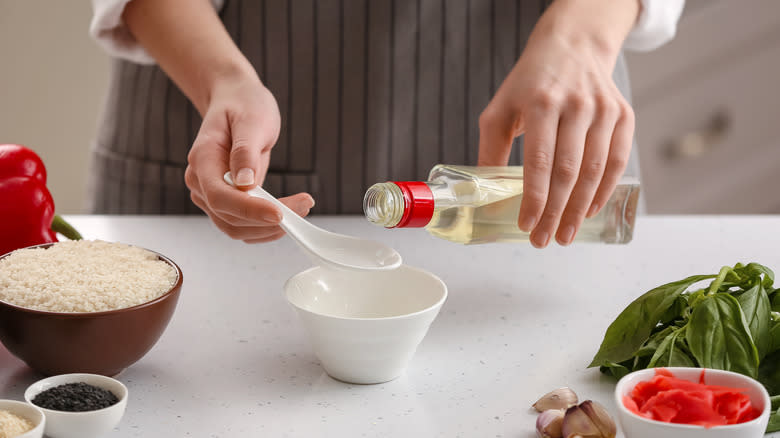
To make sweet and sour sauce, one needs something sweet and something sour. The sweet in this case can range from sugar to honey to various kinds of syrup, or from fruit juices to melted candy. For the sour, white rice vinegar is usually the go-to choice, but soy sauce or even Worcestershire sauce can be used. Other ingredients like ginger, garlic, or green onions may also show up, depending on the recipe.
If you wanted to make your own sweet and sour sauce at home, you could whip up a batch in a matter of minutes. All you would need to do would be to whisk together some pineapple juice, some rice vinegar, some brown sugar, some soy sauce, and a bit of ketchup in a pan on the stove. Bring it to a boil and then stir in some cornstarch and water to thicken it, and that's it! You've got your very own sweet and sour sauce, and you didn't even need any of those little packets you get at a Chinese restaurant.
What Does Sweet And Sour Sauce Taste Like?
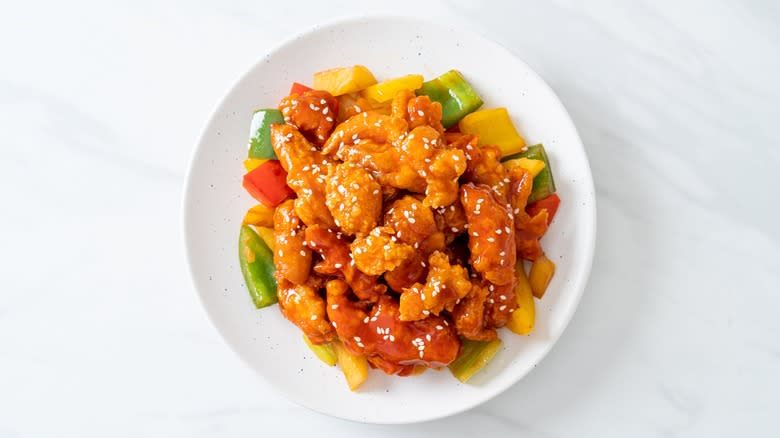
We now know what it is made out of, but what does sweet and sour sauce taste like other than the obvious? This question is tough to answer, due to its many variations. Different ways of preparing the sauce and the different ingredients used by different chefs or different brands can change a lot, but most sweet and sour sauce has a tangy, sweet flavor that is usually fairly high in acidity and lightly fruity. If tomato sauce is used, this flavor will come through as well. You may also taste other ingredients like garlic or green onion if they are present, and homemade sweet and sour sauce often contains ketchup, of which you may also get a hint.
Unlike some of the other condiments you can find at Asian restaurants, the classic sweet and sour sauce is not spicy. This makes it an appealing option for even the less adventurous eaters, as well as for children, who have been known to use it as a dipping sauce for chicken nuggets.
How To Cook With Sweet And Sour Sauce
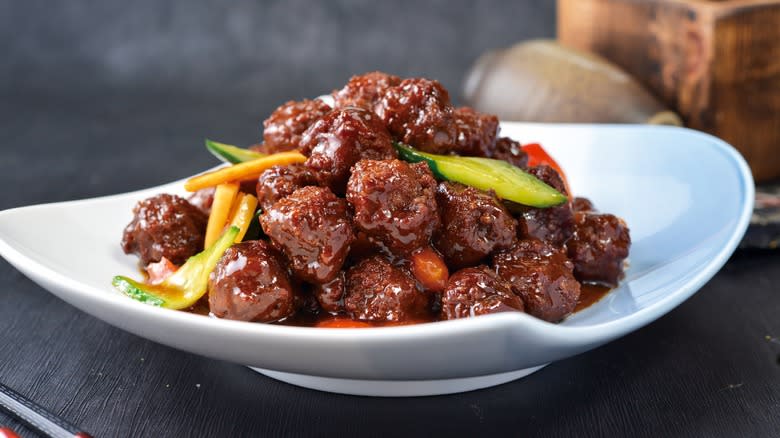
Sweet and sour sauce is a very versatile ingredient. It can be used as a dipping sauce for meats or vegetables, or it can be used as a glaze for things like chicken and pork. It can also be used as part of a marinade if you'd like your meats to be as sweet as they are savory.
Cooks on Reddit recommend using it as a topping for sauteed broccoli and carrots to make a healthy side dish more appealing. You can also make stir-fries, sweet and sour meatballs, sweet and sour noodles or rice, or think outside the box and create a dip or spread with cream cheese or mayonnaise.
There is, of course, the classic sweet and sour chicken with peppers and pineapple chunks, but there are also dishes like sweet and sour kielbasa with pineapple or pork fried rice meatballs or sweet and sour pot roast. You can even make vegetarian or vegan meatballs and use the sweet and sour sauce as a glaze. Really, the sky is the limit with this tasty condiment!
Where To Buy Sweet And Sour Sauce

Luckily for sweet and sour fans, this sauce is readily available at most supermarkets and grocery stores. While there may be a section or an aisle specifically devoted to Asian cuisine, you can also usually find sweet and sour sauce alongside other condiments like ketchup and mustard. It will usually be next to the soy sauce.
If you aren't in the mood to actually, physically go shopping, you can also easily order sweet and sour sauce online. Catch-all websites like Amazon have many options, but you can also find them on the websites of your favorite physical grocery stores like Walmart, Kroger, and Target. Just like in brick-and-mortar stores, you will most likely find a mix of store-brand sauces and sauces from popular restaurant chains like Panda Express and P.F. Chang's. You may even be able to buy a bottle at some Asian restaurants, but this is rare, as many of them make their own sweet and sour sauce in-house and don't sell it on its own.
Purchase Panda Express Sweet & Sour Sauce at Kroger for $4.99.
Purchase La Choy Sweet and Sour Stir Fry Sauce and Marinade at Walmart for $5.59.
Purchase Kikkoman Sweet & Sour Sauce at Target for $2.79.
Nutritional Information About Sweet And Sour Sauce

As with most things, the nutrition facts about sweet and sour sauce vary from brand to brand and between homemade and store-bought. To give a general look at a typical bottle of commercial sweet and sour sauce, however, we can start with the calories. For every tablespoon of sweet and sour sauce (around 16 grams), you get 25 calories. You also get 86mg of sodium, which is four percent of the recommended daily value.
You also get 6.1 grams of carbohydrates (two percent of the daily value), of which 3 grams are sugar. There is no protein (which is to be expected, as most condiments don't contain protein or contain only very minimal amounts), and not much in the way of vitamins and nutrients either. There are 16mg of potassium, but this is such a low amount that it does not even register on the daily value scale.
When you think about the nutritional value of sweet and sour sauce and whether or not it is good for your individual diet, the main thing you have to keep in mind is what you are putting it on or what you are dipping in it. Since you most likely won't be drinking it straight out of the bottle with a straw (hopefully), what is more important here is the nutritional value of the rest of your meal, as sweet and sour sauce itself is just a tiny portion of what you are eating.
Variations Of Sweet And Sour Sauce Around The World
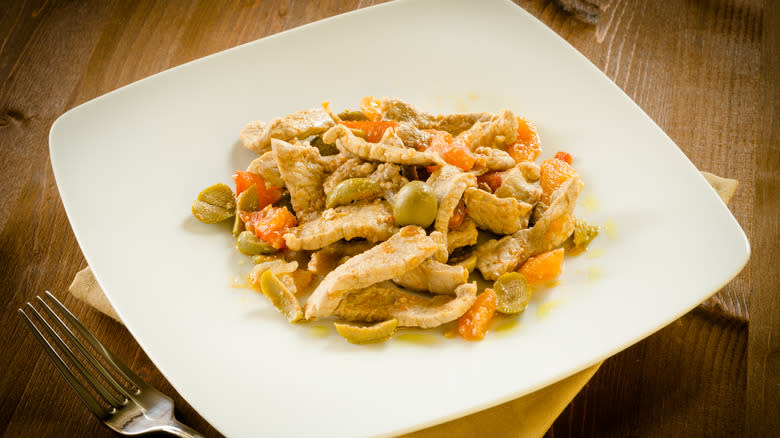
While you might be tempted to think that sweet and sour sauce is an exclusively Asian invention, this is actually far from the truth. There are versions of sweet and sour sauce and dishes all over the world, developed independently from the Chinese version. Take, for instance, agrodolce in Italy. This take on the sweet and sour flavor combo uses red wine vinegar for the "sour" and sugar or caramelized onions for the "sweet," and can be used as a condiment or as a sauce for things like porch chops, steak, and chicken.
Thailand's nam chim kai, on the other hand, is a spicier take on sweet and sour, with the addition of chili peppers to the sweet and sour mix. This one is often used as a dipping sauce for seafood or egg rolls, or as an add-in for noodles or stir-fries. Both of these versions, as well as South Africa's chakalaka and hundreds of others, sprang up in response to the apparently universal desire to mix two flavors that don't seem like they should go together: sweet and sour.
How To Store Sweet And Sour Sauce

The rules about sweet and sour sauce storage are pretty simple and easy to follow. For one thing, you can keep an unopened bottle of sweet and sour sauce in the pantry up to 12 to 18 months past the expiration date on the bottle as long as you keep that pantry free of heat and moisture. After you have opened the bottle, you should keep it in the refrigerator, where it will stay good for six months to a year.
When it comes to homemade sweet and sour sauce, however, the advice changes. After you make the sauce, you should keep it refrigerated, but only for one to two weeks. After that, it may no longer be fresh, or may even be spoiled.
Whether you are using store-bought or homemade sauce, you should keep it in an airtight container, and if you use a spoon to get some out of the bottle or jar, you should always use a clean one so as not to add bacteria to the mix. Bacteria can cause the sweet and sour sauce to spoil, which will be evident by a separation in the sauce, a color change, or the presence of mold. You can also tell the sauce has gone bad if it smells bad or has an aftertaste that is unpleasantly sour.
Read the original article on Daily Meal.

